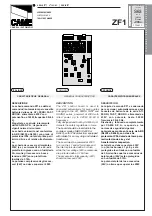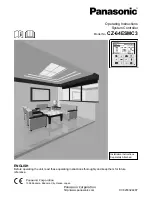
Remote Programming
93
CTC100 Programmable Temperature Controller
Identical to
*OPC
t provide any explicit indication to the I/O port when the wait is
complete.
P rogram menu
The
program.
prefix can be used but is not necessary for these instructions.
abortMacro "
Macro content
"
Defines an abort macro. The abort macro is run if the macro that defined it is aborted with an
abort
or
kill
instruction, or is stopped from Program or Setup screens. The abort macro is not
run if the macro ends normally, if a
*RST
instruction is issued, if a
reset(running macros)
instruction is issued, or if a
reset(all)
instruction is issued. The abort macro also does not run
if the macro is aborted before the
abortMacro
instruction is reached; therefore, this instruction
should usually be at the beginning of the macro. The
abortMacro
instruction only affects the
macro that called it, and has no effect on any other macros.
clearerrors
Erases all error messages for the port over which the instruction was transmitted. Also clears all
messages from the System.Com.Errors window, regardless of which port generated them.
cls
screen, if the program is selected on the program
There is no
cls?
query
define "
Macro name
", "
Macro content
"
Saves a macro. The first argument is a file name under which to save the macro; the second
argument is the content of the macro. Once a macro is saved, it can be called from another macro
by issuing the file name like any standard instruction. The saved macro can also be started from the
Program screen via the Load button or by touching the Progress window.
If a macro is already saved under the indicated name, the old macro is overwritten. If a file name
conflicts with the name of a built-in instruction, the macro takes precedence if the command is
issued with a capitalized first letter; the built-in instruction takes precedence if the command is
issued with a lower-case first letter.
A single macro cannot both define a macro and call it. Calls to submacros are replaced with the
full text of the submacro before the macro starts to run,
define the macro until run time.
Example:
define Hello([print "Hello world!" pause 1 s]3)
Hello
Like all instruction arguments, the macro content must be 256 or fewer characters in length. To
define a macro longer than 256 characters, instead of using the
define
instruction, save the
macro on a USB memory device. First, use a text editor on a PC to compose the macro, and save
it as a text file. The name of the text file should be the name of the macro plus the extension
the root directory of a USB memory
device, and then plug the USB device into the CTC100. The macro should now be available for
use as long as the USB device is plugged in.
Summary of Contents for CTC100
Page 1: ...Version 2 1 May 14 2019 User Manual CTC100 Cryogenic Temperature Controller...
Page 6: ......
Page 8: ......
Page 12: ......
Page 25: ...Operation 13 CTC100 Programmable Temperature Controller...
Page 85: ...Operation 73 CTC100 Programmable Temperature Controller To disable cascade cont select it...
Page 128: ......
Page 129: ...Remote Programming 117 CTC100 Programmable Temperature Controller...
Page 130: ......
Page 142: ......
Page 150: ......
Page 176: ......
















































